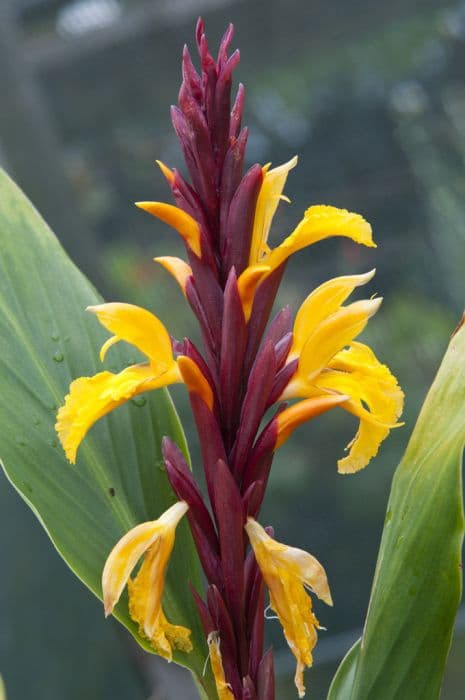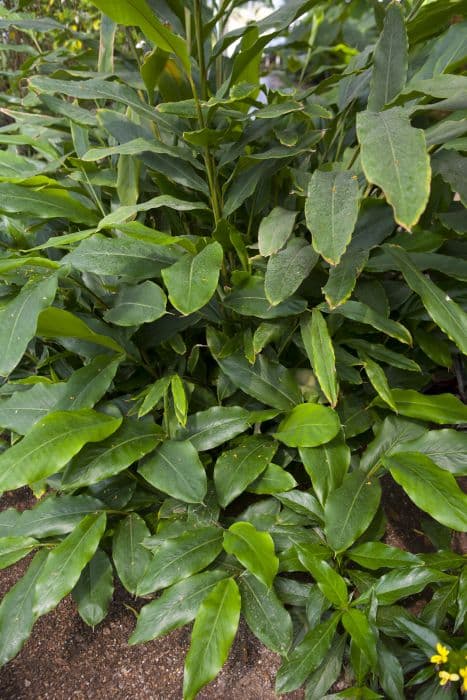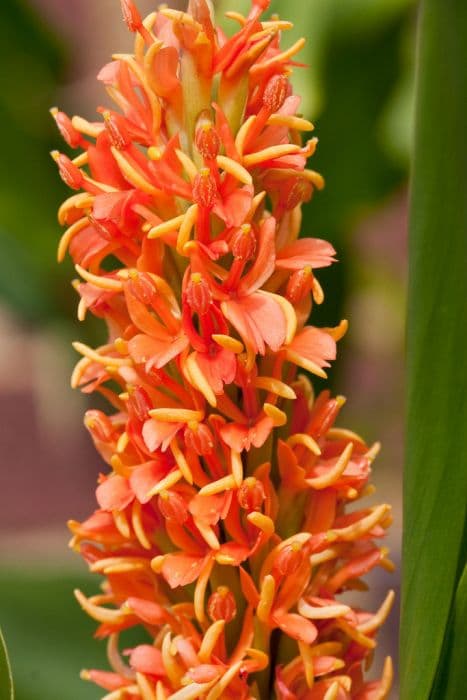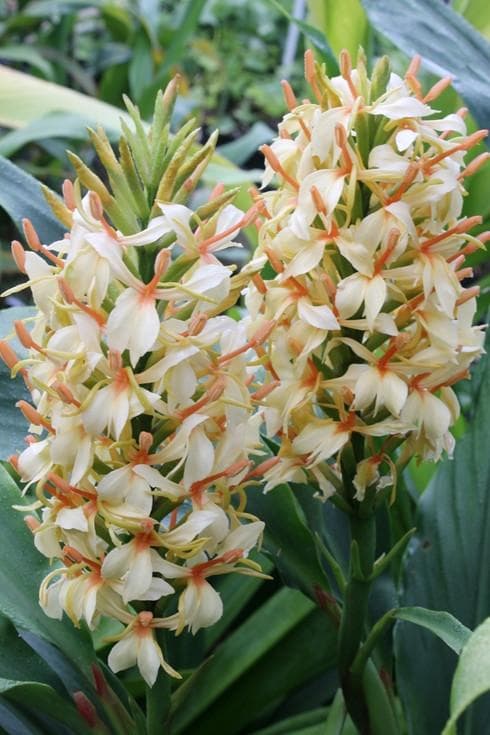Hardy Ginger Lily Cautleya spicata 'Robusta'

ABOUT
Cautleya spicata 'Robusta', commonly known as Hardy Ginger Lily, is an attractive herbaceous perennial that adds a tropical flair to gardens. It features lance-shaped, rich green leaves that gracefully arch, creating a lush and dense foliage. During the blooming season, the plant produces striking flower spikes that bear clusters of yellow to bright orange blossoms, sometimes with a subtle reddish hue at the base. These flowers are encased in large bracts that may be a deep red or burgundy shade, which adds a dash of contrasting color against the greenery. The blooms are known for their exotic and intricate appearance, drawing attention with their unusual form which resembles orchids or tropical birds. As the ginger lily grows, it forms clumps that give it a bushy, full look, with the flower spikes elegantly rising above the leaves. The vibrant colors and the unique structure of the blossoms make this plant a standout in any garden setting.
About this plant
 Names
NamesFamily
Zingiberaceae.
Synonyms
Robust Cautleya, Hardy Ginger Lily, Spiked Cautleya.
Common names
Cautleya spicata 'Robusta'.
 Toxicity
ToxicityTo humans
Cautleya spicata 'Robusta', commonly known as Hardy Ginger, does not have a well-documented profile regarding its toxicity to humans. There is no widespread evidence suggesting that Hardy Ginger is poisonous when touched or ingested by humans. However, as with many plants, it's always advisable to exercise caution, as individual allergies or sensitivities can occur. If a person were to experience symptoms after ingesting Hardy Ginger, it is recommended to seek medical attention, but specific symptoms of poisoning are not commonly reported in the literature for this plant.
To pets
Hardy Ginger is not widely reported to be toxic to pets. There is limited information on the toxicity of Cautleya spicata 'Robusta' to pets such as dogs and cats. Therefore, it is not considered to be a commonly poisonous plant to pets. However, it is still recommended to keep an eye out for any unusual symptoms if your pet ingests this plant and contact your veterinarian as a precautionary measure. Typical signs of plant toxicity in pets include vomiting, diarrhea, salivation, lethargy, or abdominal pain, though these symptoms are not specifically associated with Hardy Ginger ingestion.
 Characteristics
CharacteristicsLife cycle
Perennials
Foliage type
Deciduous
Color of leaves
Green
Flower color
Yellow
Height
2 feet (0.61 meters)
Spread
2 feet (0.61 meters)
Plant type
Herb
Hardiness zones
7
Native area
Himalayas
Benefits
 General Benefits
General Benefits- Attractive flowering: Cautleya spicata 'Robusta', commonly known as Hardy Ginger Lily, produces vibrant yellow to red flowers that add aesthetic appeal to gardens and landscapes.
- Easy to grow: This plant is relatively low-maintenance, requiring minimal care once established, making it suitable for gardeners of all skill levels.
- Shade tolerance: Hardy Ginger Lily is well-suited for shady areas where other flowering plants might struggle to thrive.
- Hummingbird attractant: The bright flowers are known to attract hummingbirds, adding to the diversity of wildlife in your garden.
- Seasonal interest: With its lush foliage and late flowering season, the plant provides interest in the garden from summer through fall.
- Container gardening: Because of its manageable size, Cautleya spicata 'Robusta' can be grown in containers, making it versatile for patios and small spaces.
- Deer resistance: This plant is generally resistant to deer, reducing the likelihood of damage from wildlife grazing.
 Medical Properties
Medical PropertiesThis plant is not used for medical purposes.
 Air-purifying Qualities
Air-purifying QualitiesThis plant is not specifically known for air purifying qualities.
 Other Uses
Other Uses- Artistic inspiration: The striking flowers of Cautleya spicata 'Robusta', commonly known as Hardy Ginger Lily, can serve as a muse for artists and photographers, inspiring artwork and providing a vibrant subject for botanical illustrations and close-up photography.
- Natural dye: The flowers and leaves of the Hardy Ginger Lily might be used to extract natural dyes for fabrics or art projects, offering hues of yellow or green, although experimentation would be required to perfect the process.
- Edible landscaping: While not commonly consumed, the Hardy Ginger Lily can be integrated into edible landscapes for its ornamental value, contributing aesthetic diversity alongside edible plants.
- Floral arrangements: Fresh or dried blooms of the Hardy Ginger Lily can add an exotic touch to floral arrangements, particularly in tropical-themed or summer bouquets.
- Perfumery: The unique fragrance of the Hardy Ginger Lily flowers has potential for use in crafting natural perfumes, essences, or scented candles, capturing the essence of a tropical garden.
- Teaching tool: This plant can be utilized in educational settings such as botanical gardens or school greenhouses, demonstrating plant growth, floral structures, and pollination strategies to students.
- Garden design: The Hardy Ginger Lily’s distinctive foliage and growth habit can be used in garden design for creating contrast with other plants or as a focal point in a shade garden.
- Eco-friendly packaging: Dried and pressed leaves or flowers of the Hardy Ginger Lily may find application as decorative elements in eco-friendly packaging designs, enhancing the visual appeal of wrapped goods.
- Cultural festivals: In regions where the Hardy Ginger Lily is culturally significant, its blooms could be used in festival decorations or ceremonies, symbolizing certain aspects of the local heritage.
- Companion planting: The Hardy Ginger Lily can be planted as a companion to other shade-loving plants, providing mutual benefits such as improved microclimate and shared pest deterrents.
Interesting Facts
 Feng Shui
Feng ShuiThe Cautleya spicata 'Robusta', commonly known as Hardy Ginger Lily, is not used in Feng Shui practice.
 Zodiac Sign Compitability
Zodiac Sign CompitabilityThe Hardy Ginger Lily is not used in astrology practice.
 Plant Symbolism
Plant Symbolism- Exotic Beauty: Cautleya spicata 'Robusta', commonly known as Hardy Ginger, often symbolizes exotic beauty due to its unusual and striking appearance that stands out in temperate gardens.
- Mystery: The rich, vibrant flowers and the subtropical origin of Hardy Ginger can represent mystery, reflecting the plant's native wild habitats that are often unexplored and enchanting.
- Protection: Hardy Ginger has a robust nature, which can be symbolic of protection and resilience, as the plant can withstand cooler climates unlike other gingers.
- Uniqueness: As a unique ornamental plant with a distinctive appearance, Hardy Ginger can be a symbol of individuality and the celebration of one's unique traits and characteristics.
- Vitality: The lively colors and vigorous growth habit of the Hardy Ginger might symbolize vitality and the abundant energy of life, characteristic of many thriving plant species.
 Water
WaterThe Hardya ginger requires consistent moisture, especially during the growing season. Water the plant deeply enough to saturate the root zone once every week, ensuring that you're providing about one to one and a half gallons of water for each application, depending on the size of the plant and the environmental conditions. During the winter dormancy period, reduce watering to every other week or when the soil feels dry to the touch, preventing the soil from becoming waterlogged. Always check the top inch of soil for dryness before watering again.
 Light
LightFor optimal growth, the Hardya ginger thrives in partial shade to filtered sunlight. The best spot for this plant would be an area that receives bright, indirect sunlight for most of the day, protecting it from the harsh afternoon sun which can scorch its leaves.
 Temperature
TemperatureThe Hardya ginger prefers a warm climate with temperatures ranging between 55 to 75 degrees Fahrenheit for ideal growth. The plant can tolerate a minimum temperature of around 40 degrees Fahrenheit, but should be protected from frost. Ideally, maintain a temperature above 50 degrees Fahrenheit to keep it thriving.
 Pruning
PruningPrune the Hardya ginger to maintain its shape and remove any damaged or diseased stems. Pruning can be done after the flowering period in late summer or early fall. Cut back the flowering stems to the base of the plant and trim any excess growth to encourage a tidy habit. It is not necessary to prune frequently—once a year is generally sufficient.
 Cleaning
CleaningAs needed
 Soil
SoilHardy Ginger Lily thrives in a well-draining, humus-rich soil mixture with a pH of 5.5 to 6.5. A blend of equal parts garden soil, peat, and perlite or coarse sand is ideal to ensure adequate drainage and aeration.
 Repotting
RepottingHardy Ginger Lily should be repotted every two to three years to refresh the soil and accommodate the plant's growth.
 Humidity & Misting
Humidity & MistingHardy Ginger Lily prefers high humidity levels, ideally between 60% to 80%, to mimic its native tropical environment.
 Suitable locations
Suitable locationsIndoor
Place Hardy Ginger Lily in bright, indirect light and maintain high humidity.
Outdoor
Plant in partial shade, protect from strong winds, and keep soil moist.
Hardiness zone
7-10 USDA
 Life cycle
Life cycleThe life of Cautleya spicata 'Robusta', commonly known as Hardy Ginger Lily, begins with seed germination, which requires warmth and moisture. After germination, the seedling emerges and establishes itself, developing a small rhizome from which foliage will grow. Over time, the plant matures and the rhizome enlarges, producing more shoots that develop into stems with characteristic lance-shaped leaves. During the growing season, typically in late summer, the plant produces flower spikes with distinctive yellow blooms that are arranged in a dense spike; these blooms attract pollinators for sexual reproduction. After flowering, if pollinated, the plant will produce seed capsules containing numerous seeds, which are then dispersed to start new plants. As a perennial, the above-ground parts of the plant die back at the onset of cold weather, while the rhizome survives underground to sprout again in the next growing season.
 Propogation
PropogationPropogation time
Spring to summer
Propogation: The best time to propagate Cautleya spicata 'Robusta', commonly known as Hardy Ginger Lily, is in the spring just as new growth begins. Division is the most popular method of propagation for this plant. To propagate by division, carefully dig up the clump of the Hardy Ginger Lily after the plant has been dormant through winter. Gently separate the rhizomes, ensuring that each division has at least one growth bud. Plant the divisions at a similar depth to how they were previously growing, which is typically about 2 to 4 inches deep (5 to 10 centimeters). Water the newly planted divisions well and maintain consistent moisture as they establish themselves. It is essential to choose a location that offers part shade to protect the plant from intense afternoon sun.









